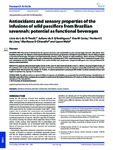Por favor, use este identificador para citar o enlazar este ítem:
http://www.alice.cnptia.embrapa.br/alice/handle/doc/1039283Registro completo de metadatos
| Campo DC | Valor | Lengua/Idioma |
|---|---|---|
| dc.contributor.author | PINELI, L. de L. de O. | pt_BR |
| dc.contributor.author | RODRIGUES, J. da S. Q. | pt_BR |
| dc.contributor.author | COSTA, A. M. | pt_BR |
| dc.contributor.author | LIMA, H. C. de | pt_BR |
| dc.contributor.author | CHIARELLO, M. D. | pt_BR |
| dc.contributor.author | MELO, L. | pt_BR |
| dc.date.accessioned | 2016-03-02T11:11:11Z | pt_BR |
| dc.date.available | 2016-03-02T11:11:11Z | pt_BR |
| dc.date.created | 2016-03-02 | pt_BR |
| dc.date.issued | 2015 | pt_BR |
| dc.identifier.citation | Journal of the Science of Food and Agriculture, v. 95, n. 7, p. 1500-1506, 2015. | pt_BR |
| dc.identifier.uri | http://www.alice.cnptia.embrapa.br/alice/handle/doc/1039283 | pt_BR |
| dc.description | Abstract: BACKGROUND: The study of biodiversity for species recovery and sustainable use has encouraged research with plants from Brazilian savannah. We aimed to characterize chemical and sensory properties of infusions of passifloras, due to their potential as functional beverages. Infusions and hydroalcoholic extracts of four species of wild passifloras, three varieties of Passiflora edulis and a commercial passiflora tea were evaluated for total phenolics (TPs), total flavonoids (TFs), condensed tannins (CTs), and antioxidant activity (DPPH and FRAP). Free-choice Profile and acceptance, compared with green tea, were performed for sensory characterization. RESULTS: In general, infusions had higher levels of TPs and CTs than hydroalcoholic extracts, which in turn had higher levels of TFs. Infusion of P. nitida showed higher amounts of TPs and antioxidant activity. Acceptance of passiflora infusions was similar or higher than that of green tea, except for P. alata. P. setacea presented a sensory profile similar to other commercial teas and higher acceptance by a group of consumers. CONCLUSION: Passiflora infusions showed different degrees of suitability as acceptable functional beverage. Identification of phenolics and other bitter compounds is needed to understand the intense bitterness of P. alata, as it did not present the highest contents of TPs, CTs and TFs. | pt_BR |
| dc.language.iso | eng | eng |
| dc.rights | openAccess | eng |
| dc.subject | Infusões | pt_BR |
| dc.title | Antioxidants and sensory properties of the infusions of wild passiflora from Brazilian savannah: potential as functional beverages. | pt_BR |
| dc.type | Artigo de periódico | pt_BR |
| dc.date.updated | 2017-02-22T11:11:11Z | pt_BR |
| dc.subject.thesagro | Maracujá | pt_BR |
| dc.subject.thesagro | Composto fenólico | pt_BR |
| dc.subject.thesagro | Antioxidante | pt_BR |
| dc.subject.thesagro | Analise organoleptica | pt_BR |
| dc.subject.thesagro | Cerrado | pt_BR |
| dc.subject.nalthesaurus | Passion fruits | pt_BR |
| dc.subject.nalthesaurus | Phenolic compounds | pt_BR |
| dc.subject.nalthesaurus | Antioxidants | pt_BR |
| dc.subject.nalthesaurus | Sensory evaluation | pt_BR |
| dc.subject.nalthesaurus | Savannas | pt_BR |
| dc.subject.nalthesaurus | Brazil | pt_BR |
| riaa.ainfo.id | 1039283 | pt_BR |
| riaa.ainfo.lastupdate | 2017-02-22 | pt_BR |
| dc.identifier.doi | 10.1002/jsfa.6852 | pt_BR |
| dc.contributor.institution | LIVIA DE L. DE O. PINELI, UNB; JULIANA DA S. Q. RODRIGUES, UNB; ANA MARIA COSTA, CPAC; HERBERT CAVALCANTE DE LIMA, CPAC; MARILEUSA D. CHIARELLO, UCB; LAURO MELO, UFRJ. | pt_BR |
| Aparece en las colecciones: | Artigo em periódico indexado (CPAC)  | |
Ficheros en este ítem:
| Fichero | Descripción | Tamaño | Formato | |
|---|---|---|---|---|
| Antioxidants.pdf | 604,22 kB | Adobe PDF |  Visualizar/Abrir |









